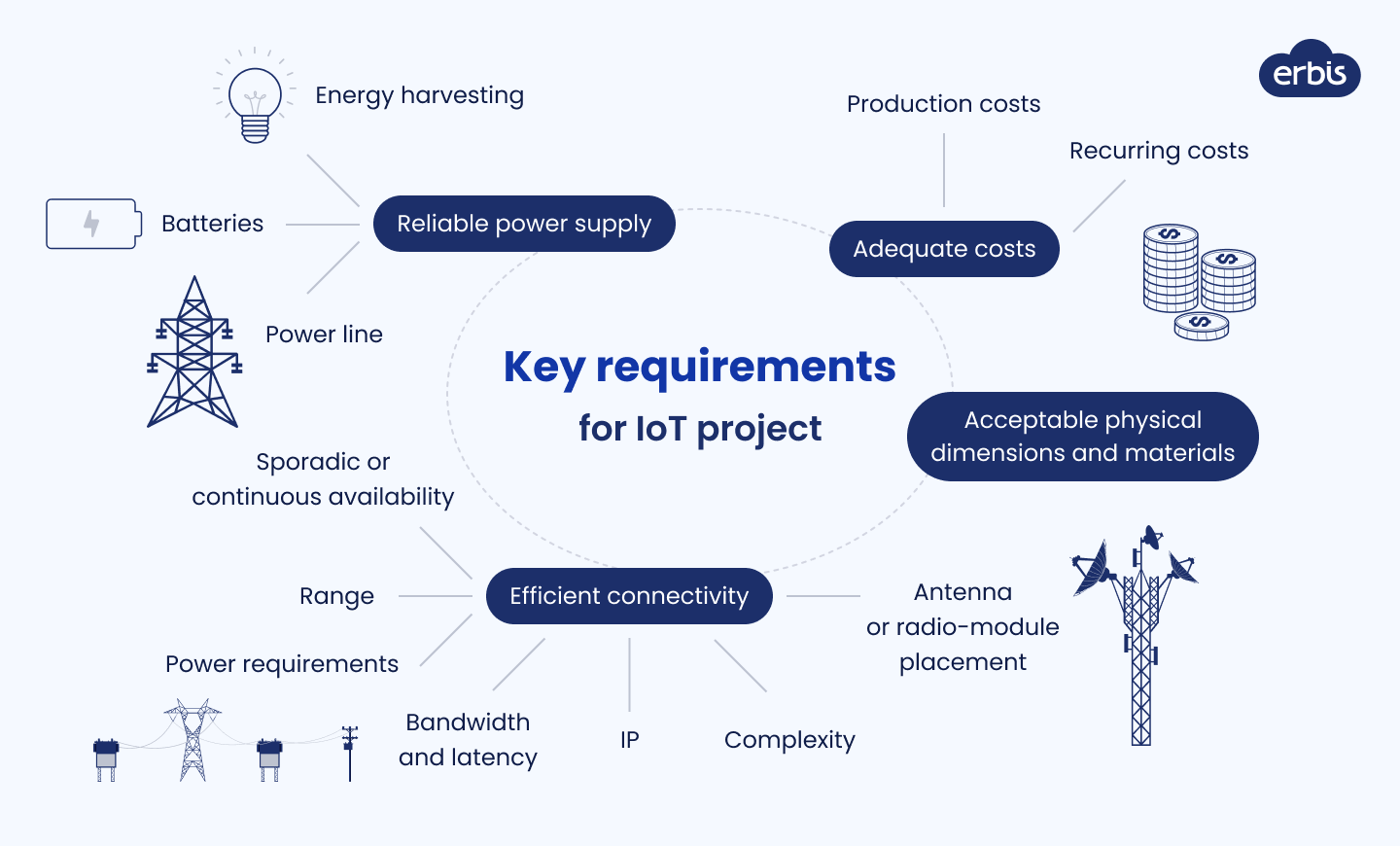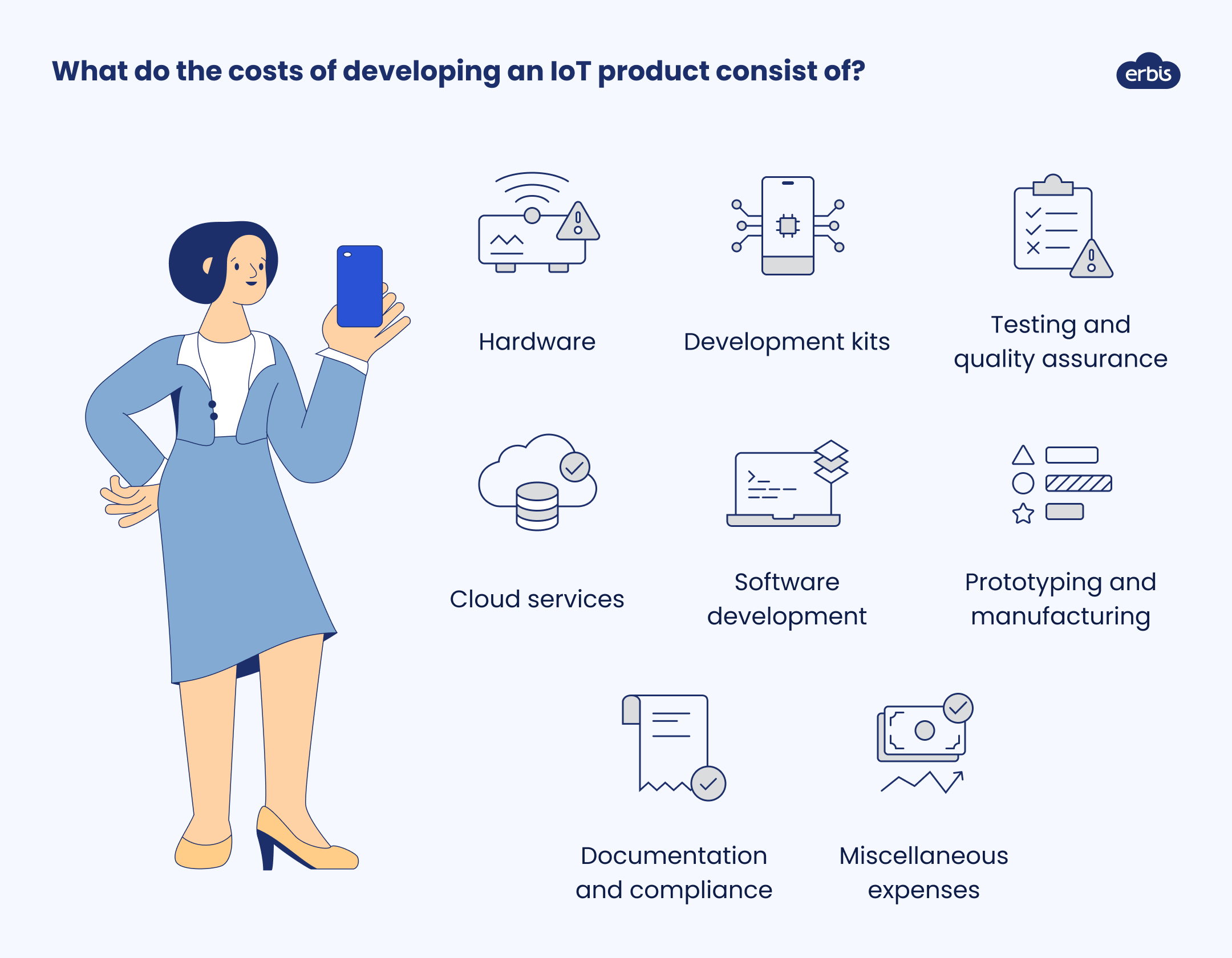How to Build MVP for IoT Product: Step-by-Step Guide
IoT (Internet of Things) development brings numerous opportunities for innovation and connectivity but also presents specific challenges.
With 26% of the IoT market growing yearly, 74% of IoT projects fail. The main reasons for this are inadequate planning and insufficient resources.
Often going all-in, many owners overspend on resources, do not acquire clients quickly enough and, as a result, fail.
However, developing a minimum viable product for IoT can help turn things around. There are key steps to approaching IoT MVP development and turning your project into a success.
Why you need IoT MVP
You need IoT MVP to test the feasibility of the IoT product idea with minimal resources. By opting for an IoT-based MVP, you can
Mitigate risks. An IoT MVP allows you to identify potential challenges and risks early in the development process. Testing the feasibility of your IoT product with a minimal investment helps uncover technical, market, or user acceptance issues, allowing for timely mitigation strategies.
Accelerate time-to-market. Speed is crucial in the competitive environment. An IoT MVP enables a quicker development cycle, allowing you to get your product to market faster. This rapid prototyping ensures a competitive edge and timely market entry.
Gather user feedback. Real-world user feedback is invaluable for refining your product. IoT MVPs help engage with end-users at the beginning of the development path. This ensures that the final product aligns closely with user expectations.
Optimize resources. Developing a full-scale IoT product is resource-intensive. An MVP IoT allows you to allocate resources by focusing on essential features. This helps you stay within the budget and deliver the necessary functionality on time.
Attract investors. A tangible IoT MVP serves as a powerful tool for attracting investors. Demonstrating a functional prototype enhances credibility and instills confidence in the potential success of the full-scale IoT product.
Refine product concept. Testing your IoT product idea through an MVP provides valuable insights into its market acceptance. Such insights help adapt the end product to market demands and enhance its chances of success.
Design a scalable product. Scalability is a critical consideration for IoT solutions. When you create IoT MVP, you can plan for a growing number of connected devices and users and develop an IT infrastructure to meet your needs.
Key steps of IoT MVP development
Developing an IoT MVP involves several key steps. Here is what you will need to do:
Step 1. Define requirements
Before you start drafting your IoT MVP product, you must identify the requirements for it. The most important aspects to define are:
Power supply. Decide whether it would be possible and convenient for the end user to
connect your device to the power line, or
run it on batteries, or
enable it by utilizing energy harvesting
Connectivity. Consider the following options for your IoT-based MVP:
Sporadic or continuous availability. If you want your IoT product to communicate with external devices like smartwatches, door locks, switches, or light bulbs, you can use NFC or Bluetooth. However, if you plan on letting users control the device from a distance or allow the device to send data to the server, you should consider other connectivity options.
Range. If you're working on a wind turbine module, NFC, Bluetooth, Thread, or ZigBee may not be suitable for your needs. Instead, you could consider using LTE, NB-IoT, or LoRaWAN. However, if your device needs to be installed in an area without coverage of these networks, you may need to explore options for satellite communication modules.
Power requirements. Classic WiFi network connections drain AA batteries within hours rather than days. That's not what your users want, right?
Bandwidth and latency. If you have a sensor that monitors the health of your crops, it does not matter much if the latency is ten milliseconds, ten seconds, or even ten hours. However, if your device monitors critical life conditions, having nearly real-time access to them is crucial.
IP. Do you require IP networking? Some protocols like Bluetooth aren't IP-compatible, even though they support some kind of networking, for example, Bluetooth Mesh.
Complexity. Installing and maintaining the device should be easy, and daily care should not be necessary.
Antenna or radio-module placement. If you want to use NFC, avoid placing the antenna behind a metal cover. If you plan to use LoRaWAN, note that the antenna length may be as long as 50cm or more.
Physical dimensions and materials. It's important to create sketches and models, aiming for a 3D-printed 1:1 model as soon as possible. This will help you seamlessly move from an IoT MVP to a market-ready product.
Financial aspects. When creating an IoT MVP, you need to draft a model that would benefit you and the end user. You will need to estimate production costs and recurring costs and define what your user will pay for and when.
Production costs include the bill of materials, tooling, and complexity of production
Recurring costs include hosting services, cloud services, connectivity services, labor costs for technical support, etc.

Step 2. Create Proof-Of-Concept (PoC)
An IoT PoC verifies the feasibility of your idea and identifies any major issues that may require significant changes in your product.
At this stage, you can use development kits or single-board computers. It is recommended to build the backend of your IoT product using a monolith architecture.
Opting for the monolith, you can significantly simplify the backend structure. This will allow you to focus on testing the core functionalities without the complexity of a distributed system. Additionally, you can run your product on a low-end virtual machine, aligning with the cost-effective approach taken during the PoC phase.
To cut costs on IT infrastructure setup, consider using free tier services from AWS, Google Cloud, or Microsoft Azure.
If you lack expertise in certain areas, conduct deeper investigations and tests before proceeding to the prototype stage. For example, you may need to build different test environments to check the antenna designs or verify the power consumption of the modules you use.
Step 3. Develop prototype and MVP for IoT product
Once you have a Proof of Concept, you can finalize the production documentation for your device prototype. At the same time, you can start working on the software for the IoT MVP.
It is essential to be very careful with the hardware from this point onwards. Any fix or change in the mechanical or electrical design may be very expensive and trigger a range of consequences.
For instance, even a minor alteration to the pressing forms used in producing the plastic cover may result in substantial financial implications, often reaching thousands of Euros. Adding an extra sensor, seemingly a simple enhancement, can necessitate updates in various mechanical parts, potentially impacting the overall dimensions of the device.
Effective collaboration between hardware and software teams becomes paramount during the development of the prototype and MVP for the IoT product. Clear communication channels and coordinated efforts are vital to ensure that any changes are seamlessly integrated without compromising the integrity of the end solution.
How much does it cost to build an IoT-based MVP?
The cost of building an IoT Minimum Viable Product can vary widely based on several factors, including the complexity of the IoT device, features, hardware components, software development, and associated services. Below are essential components of IoT MVP development and their potential costs:
Hardware
Microcontroller/processor: $5 - $50
Connectivity module (e.g., Wi-Fi, Bluetooth): $5 - $20
Sensors (e.g., temperature, motion): $2 - $20 each
Power supply/battery: $5 - $20
Enclosure/casing: $5 - $20
Development tools and kits
IoT development board/kit: $20 - $100
Software development tools: $0 - $500 (depending on the tools used)
Cloud services
Cloud platform (e.g., AWS, Azure): Costs can vary based on usage. Many cloud providers offer free tiers for initial development
Database services: Costs depend on the amount of data storage and retrieval.
Software development
Development costs: vary based on hourly rates. Developers may charge $30 - $150 per hour. For an optimal price/quality ratio, consider outstaffing IoT development in Poland
Testing and quality assurance
Testing tools and services: $0 - $500
Testing labor costs: Varies based on testing complexity.
Prototyping and manufacturing
PCB prototyping: $50 - $500
3D printing for enclosures: $20 - $200
Manufacturing setup costs: vary based on a production scale.
Documentation and compliance
Technical documentation: $500 - $2,000
Certification and compliance: costs vary based on industry standards.
Miscellaneous expenses
Shipping and logistics: Varies based on location and scale.
Contingency: 10% - 20% of the total budget for unforeseen expenses.
The overall cost of IoT-based MVP development can range from a few thousand dollars to tens of thousands, depending on the complexity and scope of the product.

IoT development: Erbis expertise
Our client, WH Bence, operates as a mobile space provider. It produces vehicles and components tailored for motorsport teams, medical institutions, and emergency services.
WH Bence approached Erbis to create a seamlessly integratable console designed for use across all vehicles produced by the company.
The project involved a complete redesign of the current dashboard.
After studying the technical documentation and conducting a code review, we did the following:
integrated specific third-party systems not usually connected to a single vehicle CPU
adjusted the remote control of headlights, hydraulics, openings, antennas, electricity generators, satellite, cellular communication systems, and meteorological equipment
ensured the control functions were appropriately set up to operate at the required speed without any delays or interruptions
Our solution for WH Bence incorporates third-party sensors through a vehicle bus of CAN standard (Controller Area Network). All essential subsystems can efficiently exchange data with the central command console through a message-based protocol.
You can read the entire case study about embeddable console development here.
Start your successful product with IoT-based MVP development
The MVP approach is essential when developing complex projects or testing risky concepts. IoT products often fall into both categories and require in-depth exploration of specific technologies, devices, and development methods.
By creating an IoT Minimum Viable Product, you can ensure its technical feasibility and market demand. You can also optimize resource allocation and avoid investing your money in a product that no one needs.
In order to create a cost-effective and valuable IoT MVP, it is important to have the support of experienced IT professionals. It is crucial to find a team of experts in hardware and software who can assess your project and suggest the best technological solutions to achieve your goal.
At Erbis, we have over 11 years of experience in software and hardware development. We create high-tech solutions that optimize business processes and enhance consumers' lives.
If you are looking for a reliable partner for IoT MVP and full-fledged product creation, contact us. We'll be happy to assist.
